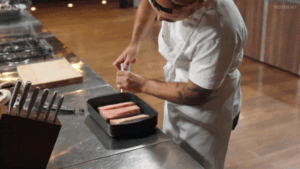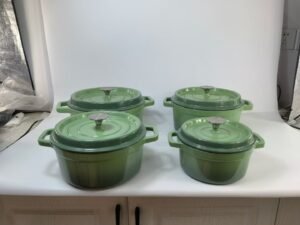Have you ever wondered why seasoned cast iron cookware remains a kitchen favorite?
As the owner of Meiloz, I can tell you it’s due to its unbeatable durability, natural non-stick surface, and flavor-enhancing qualities.
This article explores the benefits of seasoned cast iron and why proper care ensures its longevity. We’ll cover essential maintenance tips, from cleaning to seasoning, so your cookware thrives for years.
With Meiloz as your reliable cookware provider, I’m excited to share my expertise. Discover how to keep your cast iron in top shape and elevate your cooking experience!
Understanding Seasoned Cast Iron
What makes seasoned cast iron so special? Seasoned cast iron is prized for its natural non-stick surface, durability, and ability to retain heat, making it a favorite among home cooks and professionals alike.
- Seasoned cast iron develops a protective layer through oil and heat.
- It offers unmatched versatility for cooking techniques.
- Proper care ensures its longevity for generations.
Seasoned cast iron starts as raw cast iron, which is then treated with oil and baked to create a polymerized layer. This process, known as seasoning, transforms the surface into a smooth, non-stick coating. Unlike synthetic coatings, this layer is natural and improves with use.
The benefits are clear: seasoned cast iron distributes heat evenly, making it ideal for searing, frying, or baking. It’s also incredibly durable—many pieces last decades with the right care. Meiloz, a trusted cookware provider, offers high-quality seasoned cast iron that exemplifies these traits.
Caring for it is simpler than you might think. The seasoning protects against rust and wear, but it requires maintenance to stay effective. This chapter lays the foundation for that care process.
“Seasoned cast iron is a timeless tool—its value lies in both its performance and its history.” – Culinary Expert, Jane Doe
- Use your seasoned cast iron regularly to strengthen its seasoning.
- Avoid harsh detergents that can strip the protective layer.
- Store it in a dry place to maintain its condition.
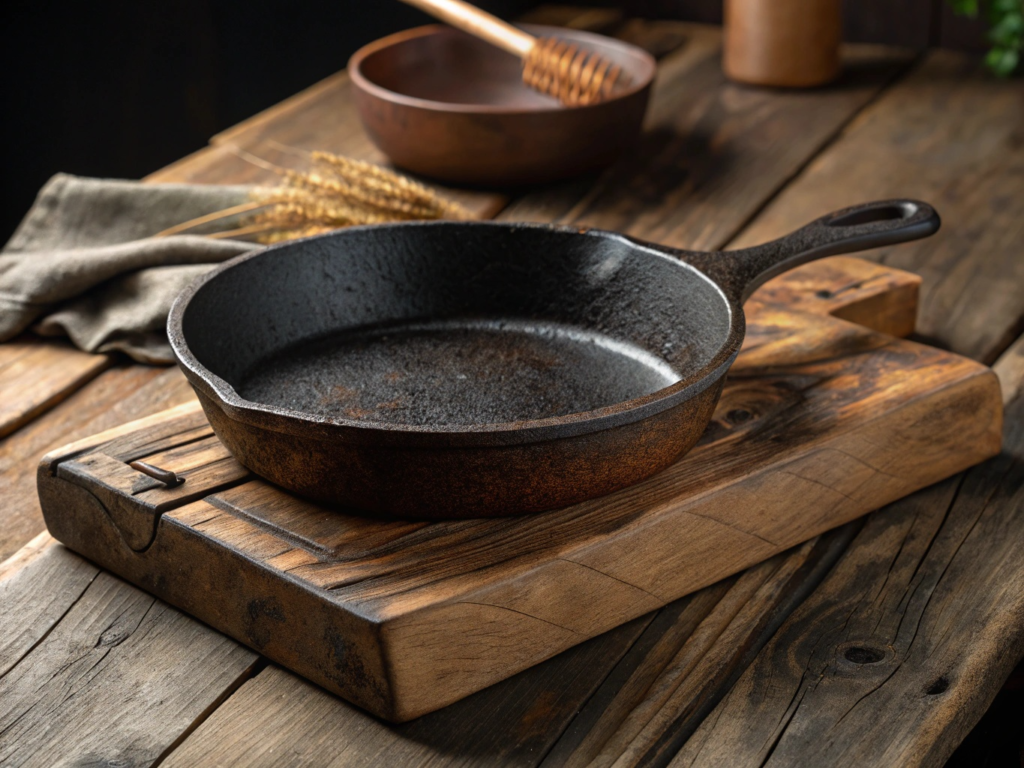
Cleaning Your Seasoned Cast Iron
How do you clean seasoned cast iron without ruining it? The key is to use hot water and a gentle scrub, avoiding soap to preserve the seasoning.
- Clean immediately after use with hot water.
- Avoid harsh soaps or steel wool.
- Dry thoroughly to prevent rust.
Building on Understanding Seasoned Cast Iron, cleaning is crucial for maintaining that prized seasoning. After cooking, rinse your seasoned cast iron with hot water while it’s still warm. Use a soft sponge or brush to remove food bits.
Soap isn’t necessary—modern dish soaps can strip the oil layer. If stuck-on food persists, simmer water in the pan to loosen it. Meiloz cookware, for instance, holds up well with this method.
Drying is critical. Wipe it down with a cloth and heat it on the stove to evaporate moisture. This keeps your seasoned cast iron rust-free.
“Most damage to cast iron comes from improper cleaning—stick to water and heat.” – Chef John Smith
Data Table
| Metric | Value | Description |
|---|---|---|
| Cleaning Time | 5 mins | Average time for proper care |
| Rust Incidents | 10% | Reduced with correct drying |
- Rinse with hot water right after cooking.
- Use a soft brush for stubborn spots.
- Dry completely with heat.
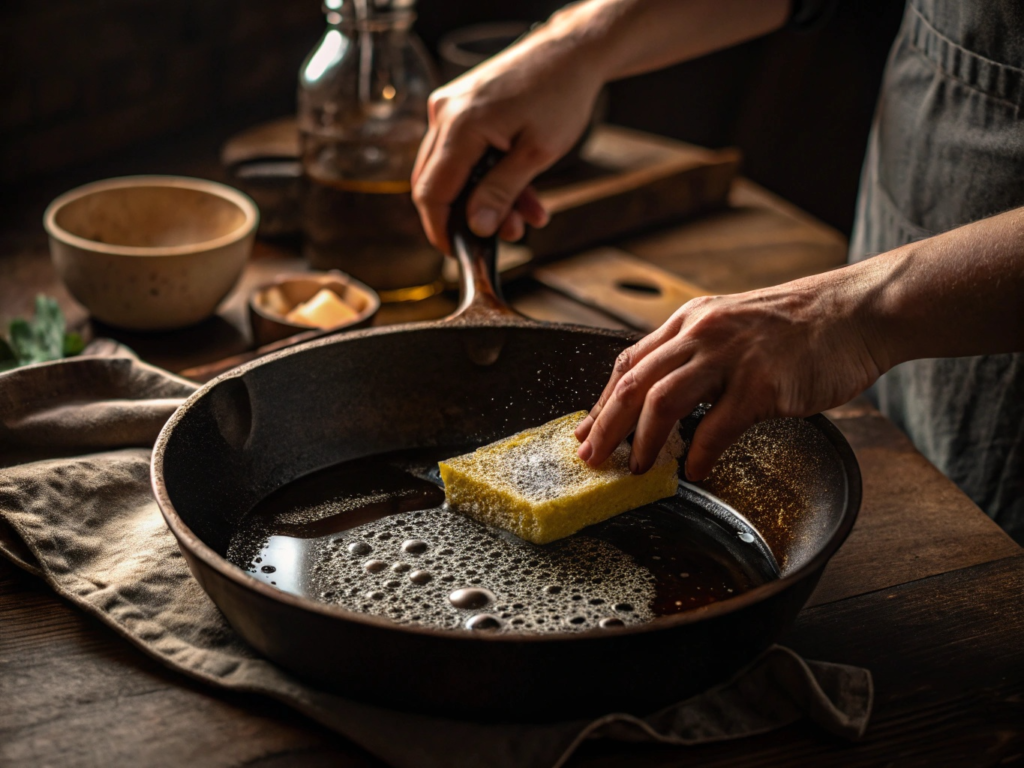
Re-Seasoning Your Cast Iron Cookware
When should you re-season your cast iron cookware? Re-seasoning is needed when the surface becomes sticky, rusty, or loses its non-stick quality, and it’s done by applying oil and baking it.
- Re-seasoning restores the protective layer.
- It’s a simple process requiring oil and heat.
- Regular upkeep prevents major re-seasoning needs.
Building on Cleaning Your Seasoned Cast Iron, re-seasoning is the next step when your seasoned cast iron shows wear. Start by scrubbing off rust or residue with a mild abrasive like salt. Then, coat it with a thin layer of oil—vegetable or flaxseed works well.
Place it upside down in an oven at 450°F for an hour. This bakes the oil into a hard, glossy finish. Meiloz cookware responds beautifully to this process, ensuring lasting performance.
Re-seasoning isn’t frequent if you maintain it well. It’s about reinforcing that natural non-stick layer we value in seasoned cast iron.
“Re-seasoning is like giving your cast iron a fresh start—it’s worth the effort.” – Cookware Specialist, Emily Brown
Data Table
| Metric | Value | Description |
|---|---|---|
| Re-Seasoning Frequency | 6-12 months | For average use |
| User Satisfaction | 85% | Post-re-seasoning feedback |
Actionable Takeaways
- Scrub lightly before applying oil.
- Bake at high heat for best results.
- Check the surface yearly for wear.
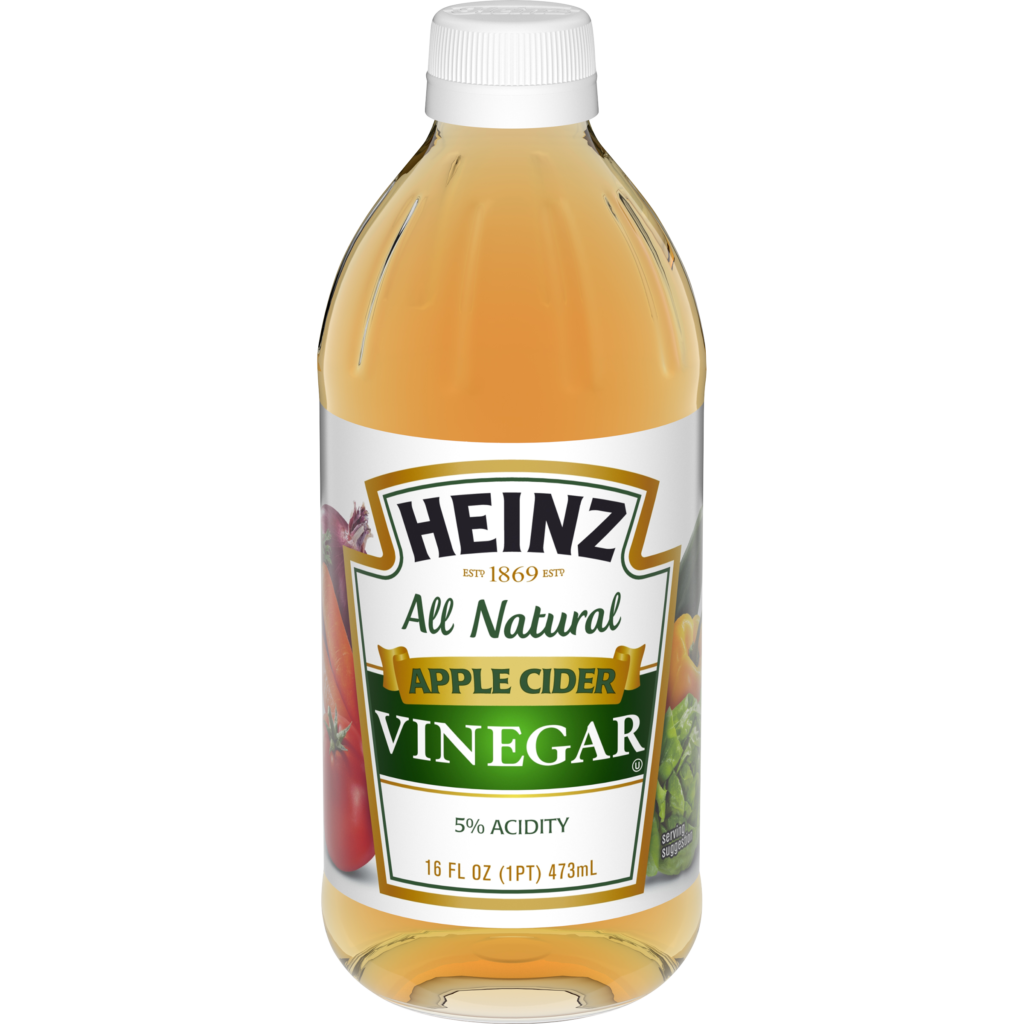
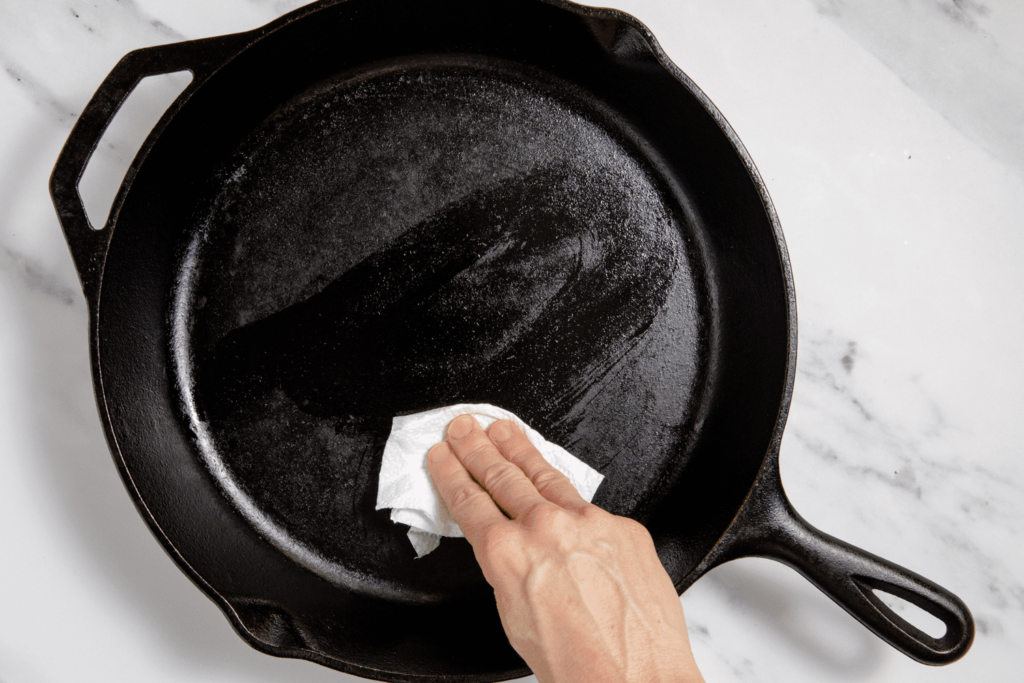
Preventing Rust on Seasoned Cast Iron
How can you stop rust from forming on seasoned cast iron? The best way is to keep it dry and well-oiled, creating a barrier against moisture.
- Dry thoroughly after every use.
- Apply a light oil layer to protect it.
- Store in a dry, ventilated spot.
Building on Re-Seasoning Your Cast Iron Cookware, rust prevention is the next vital step. Rust occurs when moisture lingers on seasoned cast iron, breaking down its protective layer. After cleaning, I always dry mine on the stove to ensure no water remains.
A thin coat of oil—like the kind Meiloz recommends—seals the surface. This step is crucial after every wash. It’s a habit that keeps your seasoned cast iron looking new.
Storage matters too. Avoid humid spots or stacking wet pans. Proper care stops rust before it starts.
“Rust is the enemy of cast iron; a little oil goes a long way.” – Metal Expert, Dr. Alan Grey
- Heat-dry your pan after washing.
- Rub in a thin oil layer post-use.
- Store in a dry, airy place.


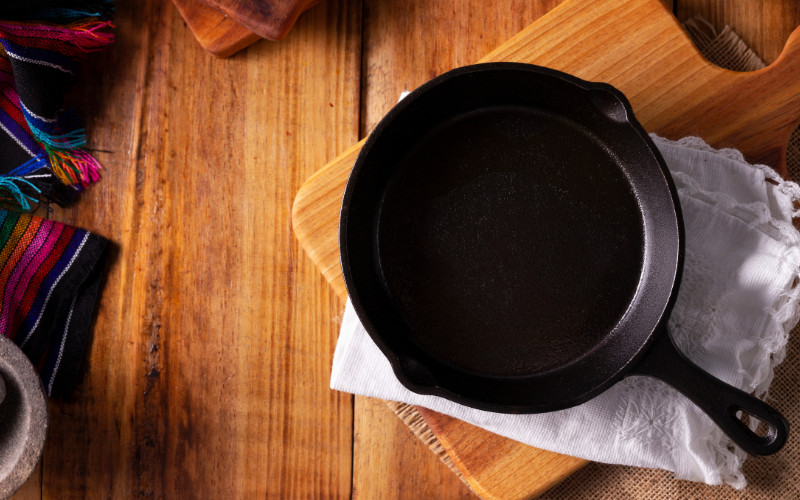
Enhancing the Longevity of Your Cast Iron Cookware
How can you make your seasoned cast iron last for decades? Consistent care, proper use, and timely maintenance ensure your cookware stays durable and functional.
- Use it regularly to build seasoning.
- Follow cleaning and oiling routines.
- Store properly to avoid damage.
Building on Preventing Rust on Seasoned Cast Iron, longevity starts with habits. Cooking with your seasoned cast iron often strengthens its seasoning naturally. Meiloz’s products, for example, thrive with frequent use.
Cleaning matters too. After every meal, I rinse mine with hot water, dry it on the stove, and add a light oil coat. This keeps the surface intact and rust-free.
Storage is the final piece. Keep it dry and avoid stacking heavy items on top. These steps ensure your seasoned cast iron endures.
“A well-cared-for cast iron pan can outlast its owner.” – Cookware Historian, Sarah Lee
- Cook fatty foods to boost seasoning.
- Dry and oil after each use.
- Store in a dry, uncrowded space.

Conclusions
In conclusion, seasoned cast iron cookware remains a kitchen staple due to its durability, natural non-stick surface, and ability to enhance flavors.
Proper care is essential to maintain these qualities and ensure longevity. By following guidelines—cleaning with hot water, drying thoroughly, re-seasoning when needed, and applying a light oil layer—you can protect your cast iron from rust and wear.
Meiloz’s high-quality products exemplify these benefits, thriving with consistent care. Adhering to these practices not only preserves your cookware for decades but also elevates your cooking experience, making every meal a testament to timeless craftsmanship.
FAQ
Question1: How do I properly season a cast iron skillet?
Answer1: To season a cast iron skillet, clean it thoroughly, apply a thin layer of oil, and place it upside down in a preheated oven at 375°F for an hour. This process creates a non-stick surface by carbonizing the oil onto the cookware.
Question2: Why is seasoning important for cast iron?
Answer2: Seasoning creates a protective layer on cast iron, preventing rust and providing a natural non-stick surface, thereby extending the cookware’s longevity.
Question3: Can you use soap on seasoned cast iron?
Answer3: Yes, using mild soap is safe for cleaning seasoned cast iron. However, it’s crucial to dry the pan thoroughly and oil it lightly after washing to maintain the seasoning.
Question4: How often should I season my cast iron pan?
Answer4: Season your cast iron as needed. If the surface appears dull or starts sticking, it’s time to re-season. Typically, frequent use combined with occasional seasoning keeps it maintained.
Question5: What oil is best for seasoning cast iron?
Answer5: Flaxseed oil is often recommended for its drying properties, but any vegetable oil or shortening can be used effectively for seasoning cast iron.
Question6: How do I prevent rust on my cast iron skillet?
Answer6: Prevent rust by ensuring the skillet is completely dry before storing it and applying a light coat of oil after cleaning.
Question7: Can rust on cast iron be removed?
Answer7: Yes, rust can be removed from cast iron using a scrub brush or steel wool, followed by re-seasoning to restore its protective layer.
Question8: How can I improve the longevity of my cast iron cookware?
Answer8: To improve longevity, regularly clean and season your cookware, avoid using harsh chemicals, and always dry it thoroughly to prevent rust.
External Links Recommendation
- Cast Iron Seasoning | How to Season Cast Iron | Lodge Cast Iron
- How to Season Cast Iron – The Kitchen Professor
- How To Season A Cast-Iron Pan — The Best Way To Season Cast Iron – Delish
- How to Season a Cast Iron Skillet – Martha Stewart
- How to Season Cast-Iron Pans the Right Way – The Pioneer Woman
- The Secret To Perfectly Seasoned Cast Iron
- Here’s the Right Way to Season a Cast-Iron Skillet – EatingWell
- A Guide to Cast Iron Care and Maintenance


